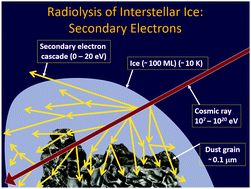Extraterrestrial prebiotic molecules: photochemistry vs. radiation chemistry of interstellar ices†
Abstract
In 2016, unambiguous evidence for the presence of the amino acid glycine, an important prebiotic molecule, was deduced based on in situ mass-spectral studies of the coma surrounding cometary ice. This finding is significant because comets are thought to have preserved the icy grains originally found in the interstellar medium prior to solar system formation. Energetic processing of cosmic ices via photochemistry and radiation chemistry is thought to be the dominant mechanism for the extraterrestrial synthesis of prebiotic molecules. Radiation chemistry is defined as the “study of the chemical changes produced by the absorption of radiation of sufficiently high energy to produce ionization.” Ionizing radiation in cosmic chemistry includes high-energy particles (e.g., cosmic rays) and high-energy photons (e.g., extreme-UV). In contrast, photochemistry is defined as chemical processes initiated by photon-induced electronic excitation not involving ionization. Vacuum-UV (6.2–12.4 eV) light may, in addition to photochemistry, initiate radiation chemistry because the threshold for producing secondary electrons is lower in the condensed phase than in the gas phase. Unique to radiation chemistry are four phenomena: (1) production of a cascade of low-energy (<20 eV) secondary electrons which are thought to be the dominant driving force for radiation chemistry, (2) reactions initiated by cations, (3) non-uniform distribution of reaction intermediates, and (4) non-selective chemistry leading to the production of multiple reaction products. The production of low-energy secondary electrons during radiation chemistry may also lead to new reaction pathways not available to photochemistry. In addition, low-energy electron-induced radiation chemistry may predominate over photochemistry because of the sheer number of low-energy secondary electrons. Moreover, reaction cross-sections can be several orders of magnitude larger for electrons than for photons. Discerning the role of photochemistry vs. radiation chemistry in astrochemistry is challenging because astrophysical photon-induced chemistry studies have almost exclusively used light sources that produce >10 eV photons. Because a primary objective of chemistry is to provide molecular-level mechanistic explanations for macroscopic phenomena, our ultimate goal in this review paper is to critically evaluate our current understanding of cosmic ice energetic processing which likely leads to the synthesis of extraterrestrial prebiotic molecules.



 Please wait while we load your content...
Please wait while we load your content...
